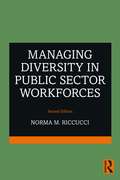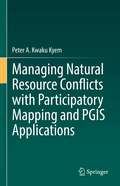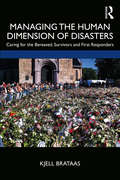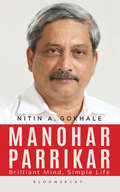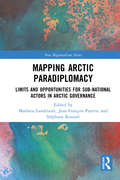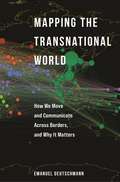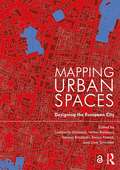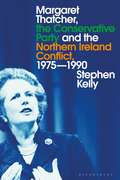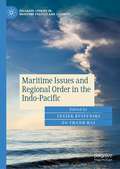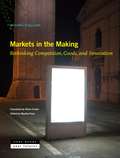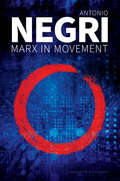- Table View
- List View
Managing Diversity In Public Sector Workforces (Essentials In Public Policy And Administration Ser.)
by Norma M. RiccucciPublic and private sector workforces in the U.S. look very different today than they did even 25 years ago. The changes are having a significant effect on how organizations manage their workforces. The old styles of managing heterogeneous workforces are proving to be ineffectual, and so management strategies aimed at embracing diversity and inclusion are essential. These strategies can have positive implications for worker satisfaction, morale and – ultimately – the delivery of public services to the American people. Managing Diversity in Public Sector Workforces, Second Edition examines demographic changes to the U.S. labor force and workplace and the ways in which government employers are managing the diverse populations that now fill public sector jobs. Addressing specific management strategies and initiatives relied on by public sector employers, as well as the implications of effectively managing variegated workforces for the overall governance of American society, this book demonstrates the importance of ensuring that programs to promote inclusiveness and diversity that appear on paper are carried through to practice through implementation. The book begins with a review of equal employment opportunity and affirmative action and the extent to which EEO and AA are still relied upon in the workplace. It then examines law and other public policy issues surrounding EEO, AA and diversity management. The remainder of the book focuses on the core of managing diversity in the public sector, exploring the initiatives, strategies, and programs that government employers either do or might rely on to ensure that the demographic mosaic embodied by their workforces is prepared to meet the needs and interests of the American citizenry of the 21st century. Data are provided on the demographics of the federal, state and local government workforces. Separate chapters address each of the following aspects of diversity: race, ethnicity, gender, LGBTQ employment, physical ability, and the intersection of these constructs. Managing Diversity in Public Sector Workforces, Second Edition will be of interest to students of public administration and public personnel management, and it is essential reading for all those involved in managing public organizations.
Managing Leader Selection in European Political Parties (Palgrave Studies in Political Leadership)
by Nicholas Aylott Niklas BolinThis book explores the varying ways in which political parties in Europe make arguably their most important decisions: the selection of their leaders. The choice shapes the representation of a party externally. It also influences the management of internal conflict, because there will always be some disagreement about the party’s direction. The rules of selection will naturally affect the outcome. Yet there is more to it than rules. Sometimes the process is open and fiercely contested. Sometimes the field of potential leaders is filtered even before the decision reaches the selectorate – the organ that, according to party statutes, formally makes the appointment. The selectorate might have only a single candidate to ratify, a so-called ‘coronation’. The book presents a framework for analysing both the formal and informal sides of leader selection, and hones the framework through its application in a series of case studies from nine European countries.
Managing Natural Resource Conflicts with Participatory Mapping and PGIS Applications
by Peter A. KyemThis book integrates spatial analysis into the study and management of conflicts, and offers a model in conflict studies that incorporates theoretical explanations of conflict, its causes, and impacts, with a geospatial strategy for intervening in disputes over allocation and use of natural resources (connects theory and practice). Alongside a theoretical analysis of resource conflicts and an account of Participatory Mapping and PGIS development, this book provides a case study of GIS applications in conflict mediation. The book also lays out a practical and straightforward demonstration of PGIS applications in conflict management using a real-world case study, and traces the Participatory Mapping and PGIS movements’ evolution, compares PPGIS and PGIS practices, and makes distinctions between traditional GIS applications and PGIS practice. The approach embodies the enhanced use of spatial information and media, sets of tools for analyzing, mapping, and displaying spatial data and a platform for participatory discussions that enhances consensus-building. The book, therefore, contributes to the search for novel approaches for managing current and emerging conflicts. With this book, resource managers, development practitioners, students, and scholars of Participatory Mapping and PGIS applications and conflict studies will be equipped with the principles, skills, and the tools they need to manage non-violent resource conflicts and keep the disputes from slipping into violence. The book will also be a valuable text for basic and advanced studies in Participatory Mapping and PGIS applications, Conflict Resolution and Conflict Management.
Managing the Human Dimension of Disasters: Caring for the Bereaved, Survivors and First Responders
by Kjell BrataasManaging the Human Dimension of Disasters provides the most comprehensive and up-to-date analysis on how individuals cope with tragedy and loss. Kjell Brataas gives a voice to those who have suffered and have been affected by unimaginable trauma. Noted experts recount stories and share their knowledge of how they assisted victims following tragedies such as the Manchester Arena bombing, the 2004 Indian Ocean tsunami, terror attacks, several aircraft disasters and school shootings, the 9/11 attacks and the COVID-19 pandemic. The book focuses on those affected by a disaster, including the bereaved, survivors and first responders. Leaders of support groups formed after these tragedies, trauma therapists and psychologists from three continents offer their experiences dealing with victims and the aftermath of disaster. Chapters provide guidance on memorializing tragedies, site visits, donation management, media relations, social media, grief counseling and human resilience. Readers will be shown that psychological support is critical after a disaster and learn from those who deal with emergencies. Brataas’ unmatched volume offers new understandings, recommendations, best practices and benchmarks on how best to assist victims in the aftermath of disaster. A valuable resource for students, researchers and practitioners.
Managing the Human Dimension of Disasters: Caring for the Bereaved, Survivors and First Responders
by Kjell BrataasManaging the Human Dimension of Disasters provides the most comprehensive and up-to-date analysis on how individuals cope with tragedy and loss. Kjell Brataas gives a voice to those who have suffered and have been affected by unimaginable trauma. Noted experts recount stories and share their knowledge of how they assisted victims following tragedies such as the Manchester Arena bombing, the 2004 Indian Ocean tsunami, terror attacks, several aircraft disasters and school shootings, the 9/11 attacks and the COVID-19 pandemic. The book focuses on those affected by a disaster, including the bereaved, survivors and first responders. Leaders of support groups formed after these tragedies, trauma therapists and psychologists from three continents offer their experiences dealing with victims and the aftermath of disaster. Chapters provide guidance on memorializing tragedies, site visits, donation management, media relations, social media, grief counseling and human resilience. Readers will be shown that psychological support is critical after a disaster and learn from those who deal with emergencies. Brataas’ unmatched volume offers new understandings, recommendations, best practices and benchmarks on how best to assist victims in the aftermath of disaster. A valuable resource for students, researchers and practitioners.
Manohar Parrikar: Brilliant Mind, Simple Life
by Nitin A GokhaleManohar Parrikar was India's first IIT-qualified Chief Minister. But that description doesn't capture even a fraction of his achievements. He used his natural brilliance to serve the country, first as a committed grass-roots volunteer, then as four-time popular Chief Minister of Goa and finally contributed to strengthening India's national security as Defence Minister between November 2014 and March 2017. Nitin Gokhale, one of South Asia's leading strategic and defence analysts, became acquainted with Parrikar quite by accident during the latter's stint in New Delhi, but by sheer coincidence the two became very close friends. This book is as much a personal tribute by the author to his friend, as an honest attempt to capture the persona of Parrikar the man,the politician and patriot. Through the eyes of his family, friends and countless admirers the book dwells deep into his early influences, his journey from a small village in Goa to one of the highest posts in the country.
Manufacturing Militarism: U.S. Government Propaganda in the War on Terror
by Christopher J. Coyne Abigail R. HallThe U.S. government's prime enemy in the War on Terror is not a shadowy mastermind dispatching suicide bombers. It is the informed American citizen. With Manufacturing Militarism, Christopher J. Coyne and Abigail R. Hall detail how military propaganda has targeted Americans since 9/11. From the darkened cinema to the football field to the airport screening line, the U.S. government has purposefully inflated the actual threat of terrorism and the necessity of a proactive military response. This biased, incomplete, and misleading information contributes to a broader culture of fear and militarism that, far from keeping Americans safe, ultimately threatens the foundations of a free society. Applying a political economic approach to the incentives created by a democratic system with a massive national security state, Coyne and Hall delve into case studies from the War on Terror to show how propaganda operates in a democracy. As they vigilantly watch their carry-ons scanned at the airport despite nonexistent threats, or absorb glowing representations of the military from films, Americans are subject to propaganda that, Coyne and Hall argue, erodes government by citizen consent.
Mapping Arctic Paradiplomacy: Limits and Opportunities for Sub-National Actors in Arctic Governance (New Regionalisms Series)
by Mathieu LandriaultThis book analyses the possibilities and limitations that sub-national actors face when developing diplomatic activities in the Arctic region. Sub-national actors, such as civil society groups and sub-national governments or administrations, have been active in international relations for decades. They face specific political and economic limitations on the international scene as non-sovereign entities. This book investigates how these actors have developed their international presence in the Arctic region. It analyzes the diplomatic activities of states, provinces, regional administrations, and multilateral forums made of sub-national governments to offer comparative insights on the strategies, interests, and activities of sub-national governments. Alaska, Scotland, Quebec, Yakutsk, and Indigenous People’s organizations are among the examples covered in this book that have forged bilateral and multilateral relations to promote and defend their interests and values. Moreover, sovereign states are often using these sub-national actors to further their own interests, as exemplified in this book in how Russia and China harnessed the potential of sub-national governments to align with their Arctic policies. The volume will be useful to academics and graduate students of Arctic politics, international relations, comparative politics, comparative federalism, foreign policy, and global governance.
Mapping Arctic Paradiplomacy: Limits and Opportunities for Sub-National Actors in Arctic Governance (New Regionalisms Series)
by Mathieu Landriault Jean-François Payette Stéphane RousselThis book analyses the possibilities and limitations that sub-national actors face when developing diplomatic activities in the Arctic region. Sub-national actors, such as civil society groups and sub-national governments or administrations, have been active in international relations for decades. They face specific political and economic limitations on the international scene as non-sovereign entities. This book investigates how these actors have developed their international presence in the Arctic region. It analyzes the diplomatic activities of states, provinces, regional administrations, and multilateral forums made of sub-national governments to offer comparative insights on the strategies, interests, and activities of sub-national governments. Alaska, Scotland, Quebec, Yakutsk, and Indigenous People’s organizations are among the examples covered in this book that have forged bilateral and multilateral relations to promote and defend their interests and values. Moreover, sovereign states are often using these sub-national actors to further their own interests, as exemplified in this book in how Russia and China harnessed the potential of sub-national governments to align with their Arctic policies. The volume will be useful to academics and graduate students of Arctic politics, international relations, comparative politics, comparative federalism, foreign policy, and global governance.
Mapping the Transnational World: How We Move and Communicate across Borders, and Why It Matters (Princeton Studies in Global and Comparative Sociology)
by Emanuel DeutschmannA study of the structure, growth, and future of transnational human travel and communicationIncreasingly, people travel and communicate across borders. Yet, we still know little about the overall structure of this transnational world. Is it really a fully globalized world in which everything is linked, as popular catchphrases like “global village” suggest? Through a sweeping comparative analysis of eight types of mobility and communication among countries worldwide—from migration and tourism to Facebook friendships and phone calls—Mapping the Transnational World demonstrates that our behavior is actually regionalized, not globalized.Emanuel Deutschmann shows that transnational activity within world regions is not so much the outcome of political, cultural, or economic factors, but is driven primarily by geographic distance. He explains that the spatial structure of transnational human activity follows a simple mathematical function, the power law, a pattern that also fits the movements of many other animal species on the planet. Moreover, this pattern remained extremely stable during the five decades studied—1960 to 2010. Unveiling proximity-induced regionalism as a major feature of planet-scale networks of transnational human activity, Deutschmann provides a crucial corrective to several fields of research.Revealing why a truly global society is unlikely to emerge, Mapping the Transnational World highlights the essential role of interaction beyond borders on a planet that remains spatially fragmented.
Mapping the Transnational World: How We Move and Communicate across Borders, and Why It Matters (Princeton Studies in Global and Comparative Sociology)
by Emanuel DeutschmannA study of the structure, growth, and future of transnational human travel and communicationIncreasingly, people travel and communicate across borders. Yet, we still know little about the overall structure of this transnational world. Is it really a fully globalized world in which everything is linked, as popular catchphrases like “global village” suggest? Through a sweeping comparative analysis of eight types of mobility and communication among countries worldwide—from migration and tourism to Facebook friendships and phone calls—Mapping the Transnational World demonstrates that our behavior is actually regionalized, not globalized.Emanuel Deutschmann shows that transnational activity within world regions is not so much the outcome of political, cultural, or economic factors, but is driven primarily by geographic distance. He explains that the spatial structure of transnational human activity follows a simple mathematical function, the power law, a pattern that also fits the movements of many other animal species on the planet. Moreover, this pattern remained extremely stable during the five decades studied—1960 to 2010. Unveiling proximity-induced regionalism as a major feature of planet-scale networks of transnational human activity, Deutschmann provides a crucial corrective to several fields of research.Revealing why a truly global society is unlikely to emerge, Mapping the Transnational World highlights the essential role of interaction beyond borders on a planet that remains spatially fragmented.
Mapping Urban Spaces: Designing the European City
by Lamberto Amistadi Valter Balducci Tomasz Bradecki Enrico Prandi Uwe SchröderMapping Urban Spaces focuses on medium-sized European cities and more specifically on their open spaces from psychological, sociological, and aesthetic points of view. The chapters illustrate how the characteristics that make life in medium-sized European cities pleasant and sustainable – accessibility, ease of travel, urban sustainability, social inclusiveness – can be traced back to the nature of that space. The chapters develop from a phenomenological study of space to contributions on places and landscapes in the city. Centralities and their meaning are studied, as well as the social space and its complexity. The contributions focus on history and theory as well as concrete research and mapping approaches and the resulting design applications. The case studies come from countries around Europe including Poland, Italy, Greece, Germany, and France, among others. The book will be of interest to students, scholars, and practitioners in architecture, urban planning, and landscape architecture.
Mapping Urban Spaces: Designing the European City
by Lamberto Amistadi Valter Balducci Tomasz Bradecki Enrico Prandi Uwe SchröderMapping Urban Spaces focuses on medium-sized European cities and more specifically on their open spaces from psychological, sociological, and aesthetic points of view. The chapters illustrate how the characteristics that make life in medium-sized European cities pleasant and sustainable – accessibility, ease of travel, urban sustainability, social inclusiveness – can be traced back to the nature of that space. The chapters develop from a phenomenological study of space to contributions on places and landscapes in the city. Centralities and their meaning are studied, as well as the social space and its complexity. The contributions focus on history and theory as well as concrete research and mapping approaches and the resulting design applications. The case studies come from countries around Europe including Poland, Italy, Greece, Germany, and France, among others. The book will be of interest to students, scholars, and practitioners in architecture, urban planning, and landscape architecture.
Margaret Thatcher, the Conservative Party and the Northern Ireland Conflict, 1975-1990
by Stephen KellyThe first woman elected to lead a major Western power and the longest serving British prime minister for 150 years, Margaret Thatcher is arguably one the most dominant and divisive forces in 20th-century British politics. Yet there has been no overarching exploration of the development of Thatcher's views towards Northern Ireland from her appointment as Conservative Party leader in 1975 until her forced retirement in 1990. In this original and much-needed study, Stephen Kelly rectifies this. From Thatcher's 'no surrender' attitude to the Republican hunger strikes to her nurturing role in the early stages of the Northern Ireland peace process, Kelly traces the evolutionary and sometimes contradictory nature of Thatcher's approach to Northern Ireland. In doing so, this book reflects afresh on the political relationship between Britain and Ireland in the late-20th century. An engaging and nuanced analysis of previously neglected archival and reported sources, Margaret Thatcher, the Conservative Party and the Northern Ireland Conflict, 1975-1990 is a vital resource for those interested in Thatcherism, Anglo-Irish relations, and 20th-century British political history more broadly.
Maria Theresa: The Habsburg Empress in Her Time
by Barbara Stollberg-RilingerA major new biography of the iconic Austrian empress that challenges the many myths about her life and ruleMaria Theresa (1717–1780) was once the most powerful woman in Europe. At the age of twenty-three, she ascended to the throne of the Habsburg Empire, a far-flung realm composed of diverse ethnicities and languages, beset on all sides by enemies and rivals. Barbara Stollberg-Rilinger provides the definitive biography of Maria Theresa, situating this exceptional empress within her time while dispelling the myths surrounding her.Drawing on a wealth of archival evidence, Stollberg-Rilinger examines all facets of eighteenth-century society, from piety and patronage to sexuality and childcare, ceremonial life at court, diplomacy, and the everyday indignities of warfare. She challenges the idealized image of Maria Theresa as an enlightened reformer and mother of her lands who embodied both feminine beauty and virile bellicosity, showing how she despised the ideas of the Enlightenment, treated her children with relentless austerity, and mercilessly persecuted Protestants and Jews. Work, consistent physical and mental discipline, and fear of God were the principles Maria Theresa lived by, and she demanded the same from her family, her court, and her subjects.A panoramic work of scholarship that brings Europe's age of empire spectacularly to life, Maria Theresa paints an unforgettable portrait of the uncompromising yet singularly charismatic woman who left her enduring mark on the era in which she lived and reigned.
Maria Theresa: The Habsburg Empress in Her Time
by Barbara Stollberg-RilingerA major new biography of the iconic Austrian empress that challenges the many myths about her life and ruleMaria Theresa (1717–1780) was once the most powerful woman in Europe. At the age of twenty-three, she ascended to the throne of the Habsburg Empire, a far-flung realm composed of diverse ethnicities and languages, beset on all sides by enemies and rivals. Barbara Stollberg-Rilinger provides the definitive biography of Maria Theresa, situating this exceptional empress within her time while dispelling the myths surrounding her.Drawing on a wealth of archival evidence, Stollberg-Rilinger examines all facets of eighteenth-century society, from piety and patronage to sexuality and childcare, ceremonial life at court, diplomacy, and the everyday indignities of warfare. She challenges the idealized image of Maria Theresa as an enlightened reformer and mother of her lands who embodied both feminine beauty and virile bellicosity, showing how she despised the ideas of the Enlightenment, treated her children with relentless austerity, and mercilessly persecuted Protestants and Jews. Work, consistent physical and mental discipline, and fear of God were the principles Maria Theresa lived by, and she demanded the same from her family, her court, and her subjects.A panoramic work of scholarship that brings Europe's age of empire spectacularly to life, Maria Theresa paints an unforgettable portrait of the uncompromising yet singularly charismatic woman who left her enduring mark on the era in which she lived and reigned.
Maritime Issues and Regional Order in the Indo-Pacific (Palgrave Studies in Maritime Politics and Security)
by Leszek Buszynski Do Thanh HaiThis edited volume examines the political and security issues influencing and shaping the developing maritime order in the Indo Pacific. If focuses specifically on the impact of China’s maritime expansion upon the policies and strategies of the regional states as well as the major players. The chapters examine the interaction of these players, paying particular attention to Japan, as the originator of the Indo Pacific idea and promoter of security cooperation and regionalism. It also covers the responses of the ASEAN claimants, Vietnam, Malaysia, the Philippines as well as Indonesia, alongside the key players, India, the US and also the EU.
The Marketisation of Higher Education: Concepts, Cases, and Criticisms (Marketing and Communication in Higher Education)
by John D. Branch Bryan ChristiansenThis edited volume explores the nature, scope, and consequences of the marketisation of higher education. Chapters identify different practices which reflect the marketisation of higher education, and offer various perspectives on the policies and procedures which stimulate and regulate it. The volume takes a holistic approach, following the notion that the marketisation of higher education both drives and is driven by the universities which form the higher education market.
Markets in the Making: Rethinking Competition, Goods, and Innovation (Near Future Series)
by Michel CallonSlicing through blunt theories of supply and demand, Callon presents a rigorously researched but counterintuitive model of how everyday market activity gets produced.If you’re convinced you know what a market is, think again. In his long-awaited study, French sociologist and engineer Michel Callon takes us to the heart of markets, to the unsung processes that allow innovations to become robust products and services. Markets in the Making begins with the observation that stable commercial transactions are more enigmatic, more elusive, and more involved than previously described by economic theory. Slicing through blunt theories of supply and demand, Callon presents a rigorously researched but counterintuitive model of market activity that emphasizes what people designing products or launching startups soon discover—the inherent difficulties of connecting individuals to things. Callon’s model is founded upon the notion of “singularization,” the premise that goods and services must adapt and be adapted to the local milieu of every individual whose life they enter. Person by person, thing by thing, Callon demonstrates that for ordinary economic transactions to emerge en masse, singular connections must be made.Pushing us to see markets as more than abstract interfaces where pools of anonymous buyers and sellers meet, Callon draws our attention to the exhaustively creative practices that market professionals continuously devise to entangle people and things. Markets in the Making exemplifies how prototypes, fragile curiosities that have only just been imagined, are gradually honed into predictable objects and practices. Once these are active enough to create a desired effect, yet passive enough to be transferred from one place to another without disruption, they will have successfully achieved the status of “goods” or “services.” The output of this more ample process of innovation, as redefined by Callon, is what we recognize as “the market”—commercial activity, at scale.The capstone of an influential research career at the forefront of science and technology studies, Markets in the Making coherently integrates the empirical perspective of product engineering with the values of the social sciences. After masterfully redescribing how markets are made, Callon culminates with a strong empirical argument for why markets can and should be harnessed to enact social change. His is a theory of markets that serves social critique.
Markets in the Making: Rethinking Competition, Goods, and Innovation (Near Future Series)
by Michel CallonSlicing through blunt theories of supply and demand, Callon presents a rigorously researched but counterintuitive model of how everyday market activity gets produced.If you’re convinced you know what a market is, think again. In his long-awaited study, French sociologist and engineer Michel Callon takes us to the heart of markets, to the unsung processes that allow innovations to become robust products and services. Markets in the Making begins with the observation that stable commercial transactions are more enigmatic, more elusive, and more involved than previously described by economic theory. Slicing through blunt theories of supply and demand, Callon presents a rigorously researched but counterintuitive model of market activity that emphasizes what people designing products or launching startups soon discover—the inherent difficulties of connecting individuals to things. Callon’s model is founded upon the notion of “singularization,” the premise that goods and services must adapt and be adapted to the local milieu of every individual whose life they enter. Person by person, thing by thing, Callon demonstrates that for ordinary economic transactions to emerge en masse, singular connections must be made.Pushing us to see markets as more than abstract interfaces where pools of anonymous buyers and sellers meet, Callon draws our attention to the exhaustively creative practices that market professionals continuously devise to entangle people and things. Markets in the Making exemplifies how prototypes, fragile curiosities that have only just been imagined, are gradually honed into predictable objects and practices. Once these are active enough to create a desired effect, yet passive enough to be transferred from one place to another without disruption, they will have successfully achieved the status of “goods” or “services.” The output of this more ample process of innovation, as redefined by Callon, is what we recognize as “the market”—commercial activity, at scale.The capstone of an influential research career at the forefront of science and technology studies, Markets in the Making coherently integrates the empirical perspective of product engineering with the values of the social sciences. After masterfully redescribing how markets are made, Callon culminates with a strong empirical argument for why markets can and should be harnessed to enact social change. His is a theory of markets that serves social critique.
Marx in Movement: Operaismo in Context
by Antonio NegriThis first volume in a new trilogy of books by Antonio Negri examines and develops the Italian tradition of radical Marxist thought known as operaismo or ‘autonomist Marxism’ – the tradition to which Negri himself adheres and in which he is a leading figure. The tradition of operaismo emphasizes the role of the worker in capitalism and the primacy of class struggle. Within this framework, Negri’s key contribution has been to theorize the transition from the ‘mass worker’ to the ‘social worker’ – that is, to broaden the concept of living labour and liberate it from the theoretical cages that locked it into the factory. It was only by moving beyond the ideology and political practice of the mass worker that the revolutionary character of the Marxist concept of class could be updated for our times and developed in relation to the exploitation and socialization of living labour, including networks of cognitive work, reproductive work and care work, networks which also have the potential to become the bases for new forms of resistance to capitalist exploitation. By bringing together Negri’s key contributions to the reconceptualization of the worker and class struggle, this volume demonstrates the vitality of the Marxist tradition of operaismo and its continued relevance for understanding the key social and political struggles of our time.
Marx in Movement: Operaismo in Context
by Antonio NegriThis first volume in a new trilogy of books by Antonio Negri examines and develops the Italian tradition of radical Marxist thought known as operaismo or ‘autonomist Marxism’ – the tradition to which Negri himself adheres and in which he is a leading figure. The tradition of operaismo emphasizes the role of the worker in capitalism and the primacy of class struggle. Within this framework, Negri’s key contribution has been to theorize the transition from the ‘mass worker’ to the ‘social worker’ – that is, to broaden the concept of living labour and liberate it from the theoretical cages that locked it into the factory. It was only by moving beyond the ideology and political practice of the mass worker that the revolutionary character of the Marxist concept of class could be updated for our times and developed in relation to the exploitation and socialization of living labour, including networks of cognitive work, reproductive work and care work, networks which also have the potential to become the bases for new forms of resistance to capitalist exploitation. By bringing together Negri’s key contributions to the reconceptualization of the worker and class struggle, this volume demonstrates the vitality of the Marxist tradition of operaismo and its continued relevance for understanding the key social and political struggles of our time.
Marxism and America: New appraisals
by Christopher Phelps Robin VandomeIn Marxism and America, an accomplished group of scholars reconsiders the relationship of the United States to the theoretical tradition derived from Karl Marx. In brand new essays that cover the period from the nineteenth century, when Marx wrote for American newspapers, to the present, when a millennial socialism has emerged inspired by the presidential campaigns of Bernie Sanders, the contributors take up topics ranging from memory of the Civil War to feminist debates over sexuality and pornography. Along the way, they clarify the relationship of race and democracy, the promise and perils of the American political tradition and the prospects for class politics today. Marxism and America sheds new light on old questions, helping to explain why socialism has been so difficult to establish in the United States even as it has exerted a notable influence in American thought.
Marxism and America: New appraisals
by Christopher Phelps and Robin VandomeIn Marxism and America, an accomplished group of scholars reconsiders the relationship of the United States to the theoretical tradition derived from Karl Marx. In brand new essays that cover the period from the nineteenth century, when Marx wrote for American newspapers, to the present, when a millennial socialism has emerged inspired by the presidential campaigns of Bernie Sanders, the contributors take up topics ranging from memory of the Civil War to feminist debates over sexuality and pornography. Along the way, they clarify the relationship of race and democracy, the promise and perils of the American political tradition and the prospects for class politics today. Marxism and America sheds new light on old questions, helping to explain why socialism has been so difficult to establish in the United States even as it has exerted a notable influence in American thought.
Marxism and History (Theory and History)
by Matt PerryThis textbook examines Marxism’s enormous impact on the way historians approach their subject. Tackling current historiographical questions in an accessible way, the author offers a clear introduction to Marxist views of history, key Marxist historians and thinkers, and the relevance of Marxist theory and history to students’ own work. This is a concise, thorough overview of an important area of historiography. The second edition incorporates significant new developments in research, including Marxist contributions to the emergence of global, maritime and transnational history; the discovery of Marx’s ecologism and the historical critique of fossil capitalism as a source of environmental disaster; a reassessment of gender oppression through social reproduction theory; and the contribution of Marxism to debates on race, Eurocentrism and whiteness.
